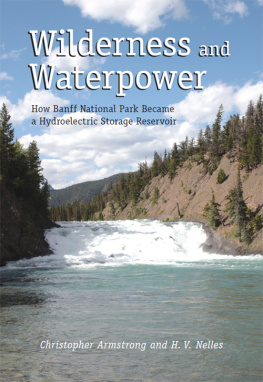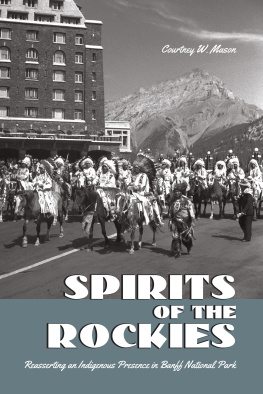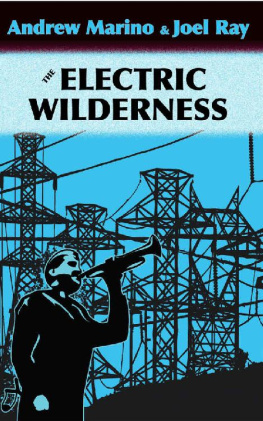Energy, Ecology, and the Environment Series
ISSN 1919-7144 (Print) ISSN 1925-2935 (Online)
This series explores how we live and work with each other on the planet, how we use its resources, and the issues and events that shape our thinking on energy, ecology, and the environment. The Alberta experience in a global arena is showcased.
No. 1 Places: Linking Nature, Culture and Planning J. Gordon Nelson and Patrick L. Lawrence
No. 2 A New Era for Wolves and People: Wolf Recovery, Human Attitudes, and Policy Edited by Marco Musiani, Luigi Boitani, and Paul Paquet
No. 3 The World of Wolves: New Perspectives on Ecology, Behaviour and Management Edited by Marco Musiani, Luigi Boitani, and Paul Paquet
No. 4 Parks, Peace, and Partnership: Global Initiatives in Transboundary Conservation Edited by Michael S. Quinn, Len Broberg, and Wayne Freimund
No. 5 Wilderness and Waterpower: How Banff National Park Became a Hydroelectric Storage ReservoirChristopher Armstrong and H. V. Nelles

2013 Christopher Armstrong and H.V. Nelles
University of Calgary Press
2500 University Drive NW
Calgary, Alberta
Canada T2N 1N4
www.uofcpress.com
This book is available as an ebook which is licensed under a Creative Commons license. The publisher should be contacted for any commercial use which falls outside the terms of that license.
L IBRARY AND A RCHIVES C ANADA C ATALOGUING IN P UBLICATION
Armstrong, Christopher, 1942
Wilderness and waterpower [electronic resource] : how Banff National Park became a hydroelectric storage reservoir / Christopher Armstrong and H.V. Nelles.
(Energy, ecology, and the environment series, 1925-2935 ; no. 5)
Includes bibliographical references and index.
Electronic monograph.
Issued also in print format.
ISBN 978-1-55238-635-4 (PDF).ISBN 978-1-55238-636-1 (PDF).ISBN 978-1-55238-637-8 (HTML)
1. Water-powerAlbertaBanff National ParkHistory. 2. Bow River Watershed (Alta.)Power utilizationHistory. 3. Reservoirs
AlbertaBanff National ParkHistory. 4. Wilderness areasEconomic aspectsAlbertaHistory. 5. Electric power consumptionAlbertaHistory. I. Nelles, H. V. (Henry Vivian), 1942- II. Title. III. Series: Energy, ecology,and the environment series (Online) ; no. 5
HD9685.C33A43 2013 333.91409712332 C2012-908283-X
The University of Calgary Press acknowledges the support of the Government of Alberta through the Alberta Multimedia Development Fund for our publications. We acknowledge the financial support of the Government of Canada through the Canada Book Fund for our publishing activities. We acknowledge the financial support of the Canada Council for the Arts for our publishing program.
This book has been published with the help of a grant from the Canadian Federation for the Humanities and Social Sciences, through the Awards to Scholarly Publications Program, using funds provided by the Social Sciences and Humanities Research Council of Canada. This project was also funded in part by the Alberta Historical Resources Foundation, using funds provided by the Alberta Lottery Fund. The Wilson Institute for Canadian History at McMaster University also provided financial support.
Cover Photo: Bow Falls in Canadian Rockies g01xm (istockphoto.com)
Cover design, page design, and typesetting by Melina Cusano
Introduction
We do not often think of the iconic Banff National Park being made to serve mundane corporate functions such as storing water for hydroelectric stations. But it does. By the same token, we do not think of electricity as being a major force in the development of national parks policy. But it was. It might be ventured that electricity was as much a factor in the history of Banff National Park as was the CPR.
Why did Banff National Park have to be significantly altered to accommodate hydroelectric storage? More broadly, how did the production and consumption of electricity in southern Alberta shape Canadas premier national park? This book attempts to answer those questions in a narrative of hydroelectric development in the Bow River watershed.
We do not mean to imply that the Banff we know is the result of something simply being plugged in. Rather, we offer an account in which path-dependent technology and hardening public policy continuously collided, driven by a relentless urban demand for electricity. But this is not a story of technological determinism. There is nothing automatic or predetermined about our story. At every point in the narrative, people made choices.
Almost from the beginning of the electric age, Banff National Park came under continuous pressure to accommodate the Calgary Power Companys need to modify the Bow River watershed to make electricity. That pressure was not absolute, but relative. It was not so much electricity itself as the method of its generation that led the power company to cast covetous eyes upon a national park. Calgary Power made a strategic decision at the outset to generate electricity using hydroelectric power. There were other ways of generating electricity. In a coal-rich region, thermal electric power represented a viable alternative. But the company chose instead to rely upon falling water in the Bow River for its energy, primarily because hydroelectricity was cheaper to produce over the long term. But as it turned out, the Bow River a glacier-fed mountain river in a region of hard winters experienced dramatic seasonal streamflow changes. As a result, it was not ideally suited to the efficient production of electricity on a constant basis throughout the year. To produce enough electricity to meet its commitments in all seasons, and to earn a profit, the company had to redesign the river to make it a better source of power. That is what led Calgary Power into a series of negotiations to create storage and generating facilities upstream in, as fate would have it, a national park.
The phrase path dependence describes a familiar predicament: early choices in system design virtually determine downstream incremental change. Or, in a more elegant formulation, path dependence exists when the present state of a system is constrained by its history. Familiar examples of this phenomenon include the gauge, or track width, of a railroad; the choice between 25 and 60 cycles, or 110 and 220 volts in electricity delivery; the QWERTY keyboard; and combined or separate sanitary and drainage sewers in cities. Once these initial choices have been made, it becomes increasingly difficult to make fundamental changes. Major change requires retrofitting or replacing the entire system, and usually it is easier and cheaper to continue on down the path selected at the beginning. The path dependence of hydroelectric generation impelled the Calgary Power Company as it searched for more capacity and more reliable power on the Bow River. And that brought Banff National Park into the crosshairs of hydroelectric engineers seeking to maximize output.
Path dependence may be a demanding master, but it is not necessarily a tyrant. It is a force exerted by the imagination and calculations of relative current cost, not by the machines themselves. It expresses itself through inertia and following the path of least resistance. Its grip can be broken, usually when incremental change no longer accommodates demand or when a new transcendent technology overshadows the legacy system. That too would happen to Calgary Power. here were always other ways to make electricity, but whenever the need for additional power arose, it seemed easier, cheaper, faster, simpler to extend the existing system rather than shift to another basic platform. Calgary Power eventually ran out of river to manage, at which point it redesigned its system around another method of power generation. This, in turn, took pressure off the river, but what would happen to those sunk hydroelectric investments on the Bow and in the park?








